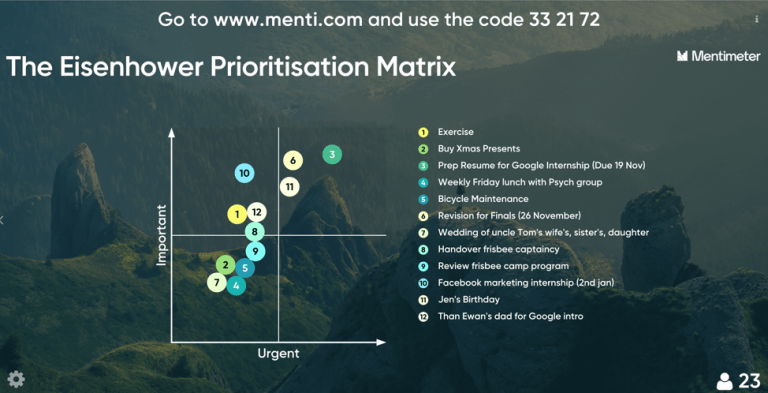Jasbir SINGH S/O Balbir Singh
NUS Centre for Future-ready Graduates
Jasbir shares practical ways in which colleagues can make their webinars
more engaging and interactive.

As educators, we take pride in creating great classroom experiences for our students. Their enthusiastic engagement is a product of our careful design and delivery of the learning experience. We walk through rows, facilitate exercises, draw up charts, and tell stories like we are standing on the red circle of a TED Talk stage. Then Covid-19 comes along and removes our bag of tricks. We are left staring into a tiny laptop camera, wondering what our participants are doing on the other end. Hello? Is anyone there?
Despite my initial fears, the experience thus far has been encouraging. I have seen workshop registrations double, and fielded more questions per class than ever before. Participants are loving the freedom to join the sessions from anywhere and the opportunity to ask questions without the pressure of being seen, heard, or judged.
My biggest insight has been that a webinar does not need to be didactic. There are many ways to make them interactive and memorable learning experiences. Here’s what I have learnt along the way.
Build An Inviting Visual Experience
Let’s put ourselves in the mind of an influencer taking a selfie.
Is my face in the centre of the screen? |
|
What will the viewer see in the background? |
|
Am I looking my viewer in the eye? |
|
For example, my colleague Ryan is sure to reach influencer status with his good eye contact and great backdrop. |
|
Is the lighting right? |
  Incidentally, in Figure 5, because this gentleman has not elevated his laptop, his students are going to be staring up at his nose the whole time. |
Don’t Forget the Audio Experience
Unless you bought the spanking new iPad Pro with its studio-quality microphones, your laptop mic is likely too far away to pick up good audio. It will sound airy and “echo-ey”. Try using Bluetooth earphones instead. No wires, no bulky frames and clean, clear audio. According to YouTube, audio is king. Viewers are more likely to continue watching a video with poor video quality than one with poor audio quality.

Make Your Participants Feel Welcomed
Create a great first impression from the beginning. Start with a carefully designed welcome slide that illustrates the topic and how participants can prepare themselves while they wait. Have some inviting music play softly in the background. As participants enter, welcome them and say their names out loud. “John, great to have you here again, how are you today?”
Shortly after, I invite participants to state their names, where they are from and what they intend to get out of the session. I proceed to spend a few minutes commenting on as many responses I can. While I am sure this warms the participants up and familiarises them with the platform and its buttons, it also raises my confidence. Seeing their responses leaves me feeling like I have got the session off to a positive and interactive start.
Make It Interactive
There are many ways to keep things interactive:
- Use the poll function on Zoom. For example, if you are teaching leadership styles, you could show a picture of Steve Jobs and ask, “What’s his leadership style?” Watch the percentage bars slide up and down as the responses come in.
- Send participants to different ‘breakout rooms’ to discuss the pros and cons of each theory you have just explained.
- Integrate tools like Mentimeter and PollEverywhere for word clouds, ratings, sorting, and more. It is exciting to see how the visuals change as real-time answers appear.

Figure 7. PLS 8004 Optimising Performance: The activity challenged students to apply the Eisenhower Matrix to help a fictional character prioritise his work. - Get students to use the annotate tool to mark up the screen. For example, you might say to your students, “On the map you see on your screen, circle the country where you come from”.
- Use the live chat for questions. Tell participants to drop their questions at any time on the chat and that you will pick them up at regular intervals.
Speak With A Smile and Raise Your Energy
For reasons unknown to me, we appear less energetic when speaking into the camera than when we are face-to-face with someone. To compensate, I have been told to smile. It conveys a positive vibe to the listener and uplifts me as I speak. Similarly, keeping my back straight and intentionally raising my energy is helpful in projecting a commanding presence in front of this virtual classroom.
Have A Smooth Ending
In my first session, I was awkward about the silence at the end so I said, “Okay, we’ve come to the end. See you next week.” I ended the meeting without giving them time to formulate a question or say their goodbyes. Now I have learnt to say, “Okay, that brings us to the end, thanks for your participation. If anyone wants to ask more questions or speak in private, I’ll be here for 10 more minutes. The rest of you, you’re free to leave. Have a great day.” I usually find that people tend to stick around to ask more questions.
Concluding Thoughts
I plan to continue running webinars even after social distancing ends. In post-session feedback surveys conducted during a recent run of webinars offered by the NUS Centre for Future-ready Graduates (CFG), 70% of respondents (I recognise the inherent selection bias here) stated they preferred it if similar topics were taught as webinars over face-to-face sessions. All our career preparation webinars received positive ratings, similar to our 2019 face-to-face sessions. That said, I will continue with face-to-face sessions for classes that benefit from kinesthetic experiential activities and feedback (for example, mock interviews and self-awareness exercises, etc). For others where online activities allow for fun engagement, practice and sufficient feedback, I will use the webinar format. What about you?
 |
Jasbir is a Senior Manager at the Centre for Future-ready Graduates (CFG). He’s passionate about empowering students with the soft skills that will enable them to thrive in the workplace. He teaches a variety of CFG workplace skills and career preparation workshops and is an instructor for PLS 8001, Cultivating Collaboration and PLS 8004, Optimizing Performance offered by the Department of Psychology in partnership with CFG. He enjoys using a variety of experiential exercises and interactive techniques to make learning personal, feedback-rich, fun and memorable. Jasbir can be reached at cfgjsbs@nus.edu.sg. |




